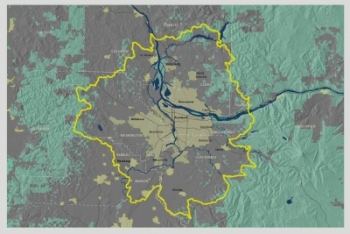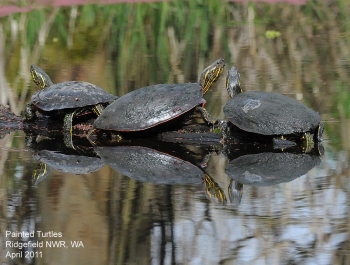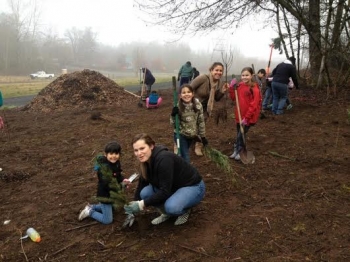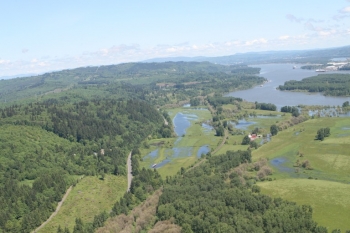Clark County: part of the natural habitat of the Intertwine human
David Cohen, February 19 2014
 Oregon and Washington – when it comes to things like bridges, taxes, political agendas and just plain attitude, the river between us can seem insurmountable.
Oregon and Washington – when it comes to things like bridges, taxes, political agendas and just plain attitude, the river between us can seem insurmountable.
Some see it that way, perhaps. For others, the Columbia River is what makes us one interconnected habitat: the heart, the spine, the natural seam of The Intertwine.
 We never questioned, as The Intertwine Alliance took shape, that our concept should find its geographic center along the Columbia. After all, habitat knows no borders. Animal migration and native plant dispersal aren’t curtailed by the complexities of hometown territoriality. Nor do pollutants, invasive species, and development politely observe the boundaries of governing jurisdictions.
We never questioned, as The Intertwine Alliance took shape, that our concept should find its geographic center along the Columbia. After all, habitat knows no borders. Animal migration and native plant dispersal aren’t curtailed by the complexities of hometown territoriality. Nor do pollutants, invasive species, and development politely observe the boundaries of governing jurisdictions.
And so we set out to launch a bi-state coalition that likewise transcended political lines on a map.
Three years later, we admit our “enlightened” approach has hit some snags, mostly of the human kind: traffic-related reluctance to cross the river, either direction, for Intertwine events, and a parallel lack of cross-state communication and cohesion.
 Yes, we were beginning to feel that the human population of The Intertwine moved at the speed of a western painted turtle when it came to embracing a bi-state identity. So we decided to start building a stronger case for getting people to think less about I-5 and more about our five watersheds.
Yes, we were beginning to feel that the human population of The Intertwine moved at the speed of a western painted turtle when it came to embracing a bi-state identity. So we decided to start building a stronger case for getting people to think less about I-5 and more about our five watersheds.
This past November, we held a listening session at the Vancouver Water Resources Education Center, inviting our Washington-side partners -- Columbia Land Trust, the Parks Foundation of Clark County, Vancouver Parks and Recreation, and Friends of Ridgefield National Wildlife Refuge, just to name a few -- to share with us their needs and goals. We expected 20 people, but over 40 enthusiastic stakeholders showed up, making the conversation deep, rich, and relevant.
 From this first meeting, we learned that our Washington partners want more unity among the many Clark County organizations focused on recreation and the environment; more support from their elected officials; and more connection with similar activities and programs across the river in Portland.
From this first meeting, we learned that our Washington partners want more unity among the many Clark County organizations focused on recreation and the environment; more support from their elected officials; and more connection with similar activities and programs across the river in Portland.
Participants like Vancouver Watersheds Alliance Executive Director Sunrise O’Mahoney shared that prior to this listening session, she often felt she’d been watching The Intertwine Alliance from the outside.
“The choices we make in Vancouver and Portland impact the entire region environmentally,” said O’Mahoney. “The more collaboration in improving the place we all live, the better.”
Now, we’re planning to expand the conversation in a larger gathering.
 In late spring 2014, we hope to convene 150 Vancouver and Clark County leaders in the environmental and recreation sectors, with the goal of catalyzing the county-wide collaboration our partners seek.
In late spring 2014, we hope to convene 150 Vancouver and Clark County leaders in the environmental and recreation sectors, with the goal of catalyzing the county-wide collaboration our partners seek.
But we hope this event also serves to remind Intertwine partners south of the Columbia that Vancouver and Clark County are our habitat’s other half -- and that regardless of what side of the river we live on, our actions, by nature, flow together.
If you'd like to get involved, let us know. And we’ll see all of you downriver.

 David Cohen, The Intertwine Alliance's Program Manager, has close to 30 years of non-profit management and program development experience. For the four years prior to joining our team, he served as the Executive Director of the
David Cohen, The Intertwine Alliance's Program Manager, has close to 30 years of non-profit management and program development experience. For the four years prior to joining our team, he served as the Executive Director of the
Add new comment